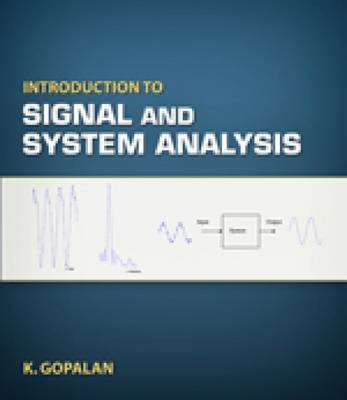
Introduction to Signal System and Analysis
Nelson Engineering (Verlag)
978-0-495-24462-2 (ISBN)
- Titel ist leider vergriffen;
keine Neuauflage - Artikel merken
The approach taken in Gopalan's text is to introduce students to the concepts and mathematical tools necessary to understand and appreciate the wide array of exciting fields in Electrical Engineering such as signal processing, control systems, and communications. The book is structured to introduce the basic continuous-time signal and system analysis concepts as an extension of familiar circuit analysis methods. A strong theoretical foundation for signal analysis is built, leading students to successfully discuss the various system analysis methods used in practice today.
Dr. Kaliappan Gopalan is Professor of Electrical Engineering at Purdue University, Calumet. He earned his Ph.D. in Engineering in 1983 The University of Akron, Akron, Ohio. Hear earned is M. Tech (EE) in 1974 at Indian Institute of Technology, Kanpur, India. B.E. (EE), 1971 P.S.G. College of Technology (Univ. of Madras), Coimbatore, India.
1 - Introduction 1.1 Signals and Systems 1.2 Classification of Signals 1.3 Analysis of Signals and Systems 1.4 Operations on Mathematically Defined Signals Summary Key Equations Further Reading Problems 2 - Mathematical Modeling of Basic Signals and Systems in Time Domain Introduction 2.1 Importance of Modeling 2.2 Basic Continuous-Time Signals 2.3 Basic Discrete-Time Signals 2.4 Sampling and Ideal, Impulse Sampled Signal 2.5 Basic System Properties 2.6 System Model from Elemental Equations 2.7 Classical Methods of Solving System Models Summary Key Equations Further Reading Problems 3 - Continuous-Time System Analysis in the Time Domain - The Convolution Integral and Classical Analysis Introduction 3.1 Impulse Response Characterization and the Convolution Integral for CT LTI Systems 3.2 Step and Other Causal Signal Response of CT LTI Systems 3.3 Properties of Convolution 3.4 LTI System Properties from Impulse Response 3.5 Obtaining the Impulse Response of CT LTI Systems 3.6 Classical Method of System Analysis from Differential Equation Model 3.7 Zero-State Response to Complex and Real Sinusoids and the System Function 3.8 Block Diagram Representation for System Simulation Summary Key Equations Further Reading Problems 4 - Discrete-Time System Analysis in the Time Domain - The Convolution Summation and Classical Analysis Introduction 4.1 Impulse Response Characterization and the Convolution Summation 4.2 Step and Other Causal Signal Response of DT LTI Systems 4.3 Properties of Convolution 4.4 LTI System Properties from Impulse Response 4.5 Obtaining the Impulse Response of DT LTI Systems 4.6 Classical Method of System Analysis from Difference Equation Model 4.7 Zero-State Response to Complex and Real Sinusoids and the System Function 4.8 Block Diagram Representation for System Simulation Summary Key Equations Further Reading Problems 5 - Frequency Domain Analysis of CT Signals and Systems - The Fourier Series and the Fourier Transform Analysis Introduction 5.1 Representation of Signals using Basic Functions 5.2 Representation of Periodic Functions - The Exponential Fourier Series 5.2.1 Existence of Fourier Series 5.2.2 Other Forms of Fourier Series 5.2.3 Frequency Spectrum of Periodic Signals 5.2.4 Fourier Series Properties 5.2.5 Fourier Series Representation of an Ideal Impulse Train 5.2.6 System Analysis for Nonsinusoidal Periodic Inputs 5.3 Frequency Spectrum of Aperiodic Signals - The Fourier Transform 5.3.1 Existence of Fourier Transform 5.3.2 Fourier Transform of Basic Signals 5.3.3 Fourier Transform Properties 5.4 LTI System Analysis in the Frequency Domain 5.5 Ideal and Practical Filters Summary Key Equations Further Reading Problems 6 - System Analysis using the Laplace Transform Introduction 6.1 The Bilateral and Unilateral Laplace Transforms 6.2 Laplace Transforms of Basic Signals 6.3 Laplace Transform Properties 6.4 Relationship between Fourier and Laplace Transforms 6.5 The Inverse Laplace Transform 6.6 Applications of the Laplace Transform in Solving Differential Equations 6.7 LTI System Response and Stability from Transfer Function 6.9 Step Response of Stable Systems 6.10 Sinusoidal Response of Stable Systems and the Frequency Response 6.11 Bode Plot 6.12 System Simulation Summary Key Equations Further Reading Problems 7 - Transfer Function Analysis of Discrete Time Systems - The z Transform Introduction 7.1 The z-Transform and Linear Time-Invariant Systems 7.2 Convergence of the z-Transform 7.3 Properties of the z-Transform 7.4 Basic z-Transforms and Inversion of z-Transforms 7.5 System Properties from H(z) 7.6 System Analysis and Frequency Response 7.7 Discrete-Time System Structures and Synthesis 7.8 System Synthesis Summary Key Equations Further Reading Problems 8 - Frequency Domain Analysis of DT Signals and Systems - The DTFT and DFT Analysis Introduction 8.1 Spectrum of Sampled Signals and the Sampling Theorem 8.2 The Discrete-Time Fourier Transform 8.3 Properties of the Discrete-Time Fourier Transform 8.4 Frequency Domain Analysis of DT Systems 8.5 Discrete Fourier Transform 8.6 Fast Fourier Transform Algorithms 8.7 FFT Application in Signal and System Analysis Summary Key Equations Further Reading Problems 9 - Multi-input, Multi-output Systems and the State Variable Analysis Introduction 9.1 State Variable Representation of CT Systems 9.2 Solution of State Equations - TIme and Laplace Domain 9.3 DT System State Models 9.4 DT System Analysis - Time and z Domain Summary Key Equations Further Reading Problems Appendix A. Complex Numbers B. Mathematical Identities and Some Useful Mathematical Operations Trigonometric Identities Finite and Infinite Series Summations Product Rule for Integration Derivative of an Integral L"Hopital"s Rule of Finding Limits Partial Fraction Expansion C. Derivation of an FFT Algorithm
| Erscheint lt. Verlag | 1.11.2008 |
|---|---|
| Zusatzinfo | Illustrations |
| Verlagsort | Florence, KY |
| Sprache | englisch |
| Themenwelt | Mathematik / Informatik ► Informatik |
| Technik ► Elektrotechnik / Energietechnik | |
| Technik ► Nachrichtentechnik | |
| ISBN-10 | 0-495-24462-7 / 0495244627 |
| ISBN-13 | 978-0-495-24462-2 / 9780495244622 |
| Zustand | Neuware |
| Haben Sie eine Frage zum Produkt? |